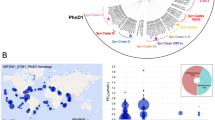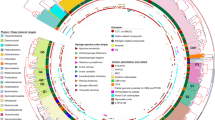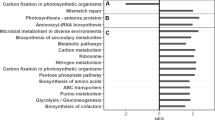Abstract
Synechococcus sp. represents an ecologically diverse group of cyanobacteria found in numerous environments, including hot-spring microbial mats, where they are spatially distributed along thermal, light and oxygen gradients. These thermophiles engage in photosynthesis and aerobic respiration during the day, but switch to fermentative metabolism and nitrogen fixation at night. The genome of Synechococcus OS-B′, isolated from Octopus Spring (Yellowstone National Park) contains a phn gene cluster encoding a phosphonate (Phn) transporter and a C–P lyase. A closely related isolate, Synechococcus OS-A, lacks this cluster, but contains genes encoding putative phosphonatases (Phnases) that appear to be active only in the presence of the Phn substrate. Both isolates grow well on several different Phns as a sole phosphorus (P) source. Interestingly, Synechococcus OS-B′ can use the organic carbon backbones of Phns for heterotrophic growth in the dark, whereas in the light this strain releases organic carbon from Phn as ethane or methane (depending on the specific Phn available); Synechococcus OS-A has neither of these capabilities. These differences in metabolic strategies for assimilating the P and C of Phn by two closely related Synechococcus spp. are suggestive of niche-specific constraints in the evolution of nutrient assimilation pathways and syntrophic relationships among the microbial populations of the hot-spring mats. Thus, it is critical to evaluate levels of various P sources, including Phn, in thermally active habitats and the potential importance of these compounds in the biogeochemical cycling of P and C (some Phn compounds also contain N) in diverse terrestrial environments.
Similar content being viewed by others
Log in or create a free account to read this content
Gain free access to this article, as well as selected content from this journal and more on nature.com
or
References
Adams MM, Gomez-Garcia MR, Grossman AR, Bhaya D . (2008). Phosphorus deprivation responses and phosphonate utilization in a thermophilic Synechococcus sp. from microbial mats. J Bacteriol 190: 8171–8184.
Allen KN, Dunaway-Mariano D . (2004). Phosphoryl group transfer: evolution of a catalytic scaffold. Trends Biochem Sci 29: 495–503.
Allewalt JP, Bateson MM, Revsbech NP, Slack K, Ward DM . (2006). Effect of temperature and light on growth of and photosynthesis by Synechococcus isolates typical of those predominating in the Octopus Spring microbial mat community of Yellowstone National Park. Appl Environ Microbiol 72: 544–550.
Avila LZ, Draths KM, Frost JW . (1991). Metabolites associated with organophosphonate C–P bond cleavage: chemical synthesis and microbial degradation of [32P]-ethylphosphonic acid. Bioorgan Med Chem 1: 51–54.
Benitez-Nelson CR, O’Neill L, Kolowith LC, Pellecia P, Thunell R . (2004). Phosphonates and particulate organic phosphorus cycling in an anoxic marine basin. Limnol Oceanogr 49: 1593–1604.
Bhaya D, Grossman AR, Steunou AS, Khuri N, Cohan FM, Hamamura N et al. (2007). Population level functional diversity in a microbial community revealed by comparative genomic and metagenomic analyses. ISME J 1: 703–713.
Burroughs AM, Allen KN, Dunaway-Mariano D, Aravind L . (2006). Evolutionary genomics of the HAD superfamily: understanding the structural adaptations and catalytic diversity in a superfamily of phosphoesterases and allied enzymes. J Mol Biol 361: 1003–1034.
Clark LL, Ingall ED, Benner R . (1998). Marine phosphorus is selectively remineralized. Nature 393: 426.
Cook AM, Daughton CG, Alexander M . (1978). Phosphonate utilization by bacteria. J Bacteriol 133: 85–90.
Dyhrman ST, Ammerman JW, Van Mooy BAS . (2007). Microbes and the marine phosphorus cycle. Oceanography 20: 110–116.
Dyhrman ST, Benitez-Nelson CR, Orchard ED, Haley ST, Pellechia PJ . (2009). A microbial source of phosphonates in oligotrophic marine systems. Nat Geosci 2: 696–699.
Dyhrman ST, Chappell PD, Haley ST, Moffett JW, Orchard ED, Waterbury JB et al. (2006). Phosphonate utilization by the globally important marine diazotroph Trichodesmium. Nature 439: 68–71.
Dyhrman ST, Haley ST . (2006). Phosphorus scavenging in the unicellular marine diazotroph Crocosphaera watsonii. Appl Environ Microbiol 72: 1452–1458.
Elser JJ, Matthew ES, Bracken E, Cleland E, Daniel S, Gruner W et al. (2007). Global analysis of nitrogen and phosphorus limitation of primary producers in freshwater, marine and terrestrial ecosystems. Ecol Lett 10: 1135–1142.
Falkowski PG, Fenchel T, Delong EF . (2008). The microbial engines that drive Earth's biogeochemical cycles. Science 320: 1034–1039.
Forlani G, Pavan M, Gramek M, Kafarski P, Lipok J . (2008). Biochemical bases for a widespread tolerance of cyanobacteria to the phosphonate herbicide glyphosate. Plant Cell Physiol 49: 443–456.
Fox EA, Mendz GL . (2006). Phosphonate degradation in microorganisms. Enzyme Microb Technol 40: 145–150.
Gilbert JA, Thomas S, Cooley NA, Kulakova A, Field D, Booth T et al. (2009). Potential for phosphonoacetate utilization by marine bacteria in temperate coastal waters. Environ Microbiol 11: 111–125.
Hildebrand RL, Henderson TG . (1983). Phosphonic acids in nature. In Hildebrand, RL (ed.). The Role of Phosphonates in Living Systems. CRC Press: Boca Raton, FL.
Hove-Jensen B, Rosenkrantz TJ, Zechel DL, Willemoes M . (2010). Accumulation of intermediates of the carbon–phosphorus lyase pathway for phosphonate degradation in phn mutants of Escherichia coli. J Bacteriol 192: 370–374.
Ilikchyan IN, McKay RM, Zehr JP, Dyhrman ST, Bullerjahn GS . (2009). Detection and expression of the phosphonate transporter gene phnD in marine and freshwater picocyanobacteria. Environ Microbiol 11: 1314–1324.
Ingall ED . (2008). Making methane. Nat Geoscience 1: 419–420.
Iqbal S, Parker G, Davidson H, Moslehi-Rahmani E, Robson RL . (2004). Reversible phase variation in the phnE gene, which is required for phosphonate metabolism in Escherichia coli K-12. J Bacteriol 186: 6118–6123.
Jiang W, Metcalf WW, Lee KS, Wanner BL . (1995). Molecular cloning, mapping, and regulation of Pho regulon genes for phosphonate breakdown by the phosphonatase pathway of Salmonella typhimurium LT2. J Bacteriol 177: 6411–6421.
Karl DM, Beversdorf L, Björkman KM, Church MJ, Martinez A, Delong EF . (2008). Aerobic production of methane in the sea. Nat Geosci 1: 473–478.
Kilian O, Steunou AS, Fazeli F, Bailey S, Bhaya D, Grossman AR . (2007). Responses of a thermophilic Synechococcus isolate from the microbial mat of Octopus Spring to light. Appl Environ Microbiol 73: 4268–4278.
Kolowith LC, Ingall ED, Benner R . (2001). Composition and cycling of marine organic phosphorus. Limnol Oceanogr 46: 309–320.
Kononova SV, Nesmeyanova MA . (2002). Phosphonates and their degradation by microorganisms. Biochemistry (Mosc) 67: 184–195, 184–195.
Lahiri SD, Zhang G, Dai J, Dunaway-Mariano D, Allen KN . (2004). Analysis of the substrate specificity loop of the HAD superfamily cap domain. Biochemistry 43: 2812–2820.
Martinez A, Tyson GW, Delong EF . (2009). Widespread known and novel phosphonate utilization pathways in marine bacteria revealed by functional screening and metagenomic analyses. Environ Microbiol 12: 222–238.
Mendz GL, Megraud F, Korolik V . (2005). Phosphonate catabolism by Campylobacter spp. Arch Microbiol 183: 113–120.
Metcalf WW, van der Donk WA . (2009). Biosynthesis of phosphonic and phosphinic acid natural products. Annu Rev Biochem 78: 65–94.
Mills MM, Ridame C, Davey M, La Roche J, Geider RJ . (2004). Iron and phosphorus co-limit nitrogen fixation in the eastern tropical North Atlantic. Nature 429: 292–294.
Nowack B . (2003). Environmental chemistry of phosphonates. Water Res 37: 2533–2546.
Orchard ED, Webb EA, Dyhrman ST . (2009). Molecular analysis of the phosphorus starvation response in Trichodesmium spp. Environ Microbiol 11: 2400–2411.
Papke RT, Ramsing NB, Bateson MM, Ward DM . (2003). Geographical isolation in hot spring cyanobacteria. Environ Microbiol 5: 650–659.
Quinn JP, Kulakova AN, Cooley NA, McGrath JW . (2007). New ways to break an old bond: the bacterial carbon–phosphorus hydrolases and their role in biogeochemical phosphorus cycling. Environ Microbiol 9: 2392–2400.
Rozen S, Skaletsky H . (2000). Primer3 on the WWW for general users and for biologist programmers. Methods Mol Biol 132: 365–386.
Sanudo-Wilhelmy SA . (2006). Oceanography: a phosphate alternative. Nature 439: 25–26.
Singh BK . (2009). Organophosphorus-degrading bacteria: ecology and industrial applications. Nat Microbiol Rev 7: 156–164.
Stauffer RE . (1982). Fluorapatite and fluorite solubility controls on geothermal waters in Yellowstone National Park. Geochemica Cosmochemica Acta 46: 465–474.
Stauffer RE, Thompson JM . (1978). Phosphorous in hydrothermal waters of Yellowstone National Park, Wyoming. J Res US Geol Surv 6: 755–763.
Steunou AS, Bhaya D, Bateson MM, Melendrez MC, Ward DM, Brecht E et al. (2006). In situ analysis of nitrogen fixation and metabolic switching in unicellular thermophilic cyanobacteria inhabiting hot spring microbial mats. Proc Natl Acad Sci USA 103: 2398–2403.
Steunou AS, Jensen SI, Brecht E, Becraft ED, Bateson MM, Kilian O et al. (2008). Regulation of nif gene expression and the energetics of N2 fixation over the diel cycle in a hot spring microbial mat. ISME J 2: 364–378.
Su Z, Olman V, Xu Y . (2007). Computational prediction of Pho regulons in cyanobacteria. BMC Genomics 8: 156–167.
Ternan NG, Mc Grath JW, Mc Mullan G, Quinn JP . (1998). Organophosphonates: occurrence, synthesis and biodegradation by microorganisms. World J Microbiol Biotech 14: 635–647.
Tetu SG, Brahamsha B, Johnson DA, Tai V, Phillippy K, Palenik B et al. (2009). Microarray analysis of phosphate regulation in the marine cyanobacterium Synechococcus sp. WH8102. ISME J 3: 835–849.
Thomas S, Burdett H, Temperton B, Wick R, Snelling D, McGrath JW et al. (2010). Evidence for phosphonate usage in the coral holobiont. ISME J 4: 459–461.
Torriani-Gorini A, Yagil E, Simon S . (1994). Phosphate in Microorganisms: Cellular and Molecular Biology. ASM Press: Washington, DC.
Van Mooy BA, Fredricks HF, Pedler BE, Dyhrman ST, Karl DM, Koblízek M et al. (2009). Phytoplankton in the ocean use non-phosphorus lipids in response to phosphorus scarcity. Nature 458: 69–72.
Ward DM . (1978). Thermophilic methanogenesis in a hot-spring algal–bacterial mat (71 to 30 degrees C). Appl Environ Microbiol 35: 1019–1026.
Whelan JA, Russell NB, Whelan MA . (2003). A method for the absolute quantification of cDNA using real-time PCR. J Immunol Methods 278: 261–269.
White AK, Metcalf WW . (2007). Microbial metabolism of reduced phosphorus compounds. Annu Rev Microbiol 61: 379–400.
Wu J, Sunda W, Boyle EA, Karl DM . (2000). Phosphate depletion in the western North Atlantic Ocean. Science 289: 759–762.
Yakovleva GM, Kim SK, Wanner BL . (1998). Phosphate-independent expression of the carbon–phosphorus lyase activity of Escherichia coli. Appl Microbiol Biotechnol 49: 573–578.
Acknowledgements
This study was supported by the National Science Foundation (EF-0328698), Stanford University (MD), Venture Grant from Colorado College (MB-H) and the Carnegie Institution (DB, MG). We thank George Asimenos for primer design, and Melissa Adams and Fariba Fazeli for expert technical assistance; Blaise Hamel and Sheila I Jensen for collecting and processing samples; the US National Park Service and personnel from Yellowstone National Park.
Author information
Authors and Affiliations
Corresponding author
Additional information
Supplementary Information accompanies the paper on The ISME Journal website
Supplementary information
Rights and permissions
About this article
Cite this article
Gomez-Garcia, M., Davison, M., Blain-Hartnung, M. et al. Alternative pathways for phosphonate metabolism in thermophilic cyanobacteria from microbial mats. ISME J 5, 141–149 (2011). https://doi.org/10.1038/ismej.2010.96
Received:
Revised:
Accepted:
Published:
Issue date:
DOI: https://doi.org/10.1038/ismej.2010.96
Keywords
This article is cited by
-
Marine picocyanobacterial PhnD1 shows specificity for various phosphorus sources but likely represents a constitutive inorganic phosphate transporter
The ISME Journal (2023)
-
Carbon-Phosphorus Lyase—the State of the Art
Applied Biochemistry and Biotechnology (2020)
-
Strains of the toxic and bloom-forming Nodularia spumigena (cyanobacteria) can degrade methylphosphonate and release methane
The ISME Journal (2018)
-
Glyphosate dose modulates the uptake of inorganic phosphate by freshwater cyanobacteria
Journal of Applied Phycology (2018)
-
Challenges of metagenomics and single-cell genomics approaches for exploring cyanobacterial diversity
Photosynthesis Research (2015)



